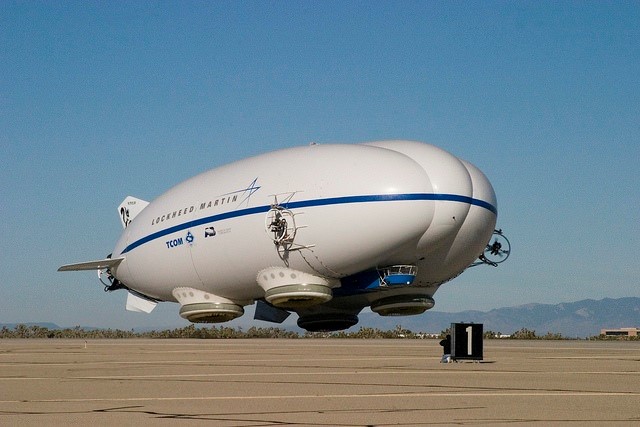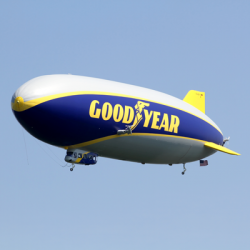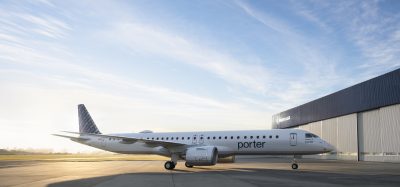The emergence of cargo airships: An opportunity for airports
- Like
- Digg
- Del
- Tumblr
- VKontakte
- Buffer
- Love This
- Odnoklassniki
- Meneame
- Blogger
- Amazon
- Yahoo Mail
- Gmail
- AOL
- Newsvine
- HackerNews
- Evernote
- MySpace
- Mail.ru
- Viadeo
- Line
- Comments
- Yummly
- SMS
- Viber
- Telegram
- Subscribe
- Skype
- Facebook Messenger
- Kakao
- LiveJournal
- Yammer
- Edgar
- Fintel
- Mix
- Instapaper
- Copy Link
Posted: 18 July 2017 | Craig Neal | Post Graduate Research Student | UNSW Australia | 1 comment
Craig Neal a Post Graduate Research Student at UNSW Australia provides an overview of the potential impact of Cargo Airship Operations on Airports, and discusses the emergence of this technology in the near future and the opportunity it presents.


The Lockheed Marin P-791 demonstrator (Lockheed Martin)
An airship is an aircraft that utilises both aerodynamic and aerostatic lift (buoyancy through a lighter than air gas), the new old technology.
This technology predates traditional aircraft by 50 years and held the record for the longest single passenger flight for more than 47 years until the introduction of the Boeing 747SP in 1975.
The progression of the modern airship
When most people hear the word airship the name Hindenburg would most likely be the first thought that comes to mind, but it has now been over 80 years since the Hindenburg disaster, and airships, like other aircraft, have progressed significantly in technology. Airships may be perceived to be old technology, but the modern generation of airships employ some of the most advanced technology in the aeronautical and aerospace industries. These airships utilise modern technology such as material sciences in the form of light-weight polymers for the envelope and carbon fibre frames, vectored thrust propeller engines, and modern avionics.


Airships are unlikely to significantly challenge traditional heavier than air (HTA) aircraft for passenger operations, however they are well suited to the transportation of cargo with its reduced priority on speed and the airship’s ability to offer a more cost effective service. Cargo airships are an emerging mode of freight transportation (designed specifically for the transportation and handling of freight) which have had many theorised designs and uses over the years, but now look to be finally emerging from the realms of theory into production in the near future, with Lockheed Martin’s LMH-1 having signed letters of intent for 24 airships and production looking to start in early 2019 . There are many designs for cargo airships, however what has changed in recent years is that several manufacturers have now flown demonstration models and in the case of UK manufacturer Hybrid Air Vehicles the full sized demonstrator “Airlander” is currently the largest aircraft (by length) in the world.
The following Table 1, gives an idea of the scale of potential cargo airships vs one of the largest HTA cargo aircraft, the Boeing 747-8F.
Table 1- Airship designs vs B747-8F – a size comparison
Airship/Aircraft
| Zeppelin NT /Goodyear LZ N07-101 | Aeroscraft ML866 | Aeroscraft ML868 | Hybrid Air Vehicles (HAV)- Airlander | Lockheed Martin LMH-1 | B747-800F |
Status ( Op- Operating/ Demo- Demonstrator only) | Operational | Demo | Design | Full size Demo | Demo | Operational |
Length (m) | 75.1 | 169 | 235 | 92 | 88.4 | 76.25 |
Width (m) | 14.2 | 54 | 90 | 43.5 | 42.7 | 68.45 |
Height (m) | 19.4 | 36.6 | 56 | 26 | 22 | 19.4 |
Static Lift (Kgs) | 1,336 | 59,870 | 226,790 | 10,000 | 21,000 | 140,000 |
Cargo Bay Dim (M) | NA | 67x12x9 | 115x19x14 | NA | 18x3x3 | – |
Cargo Bay Vol () | NA | 7,236 | 30,590 | NA | 162 | 736 |
Production Date | In production | Estimated 2019 | Estimated 2022 | Unknown | 2019* | In production |
* Lockheed Martin currently have letters of intent for 24 LMH-1’s which should enter production in early 2019.
Why the emergence of cargo airships now?
The aviation industry is at an interesting turning point with:
- Advances in technology being integrated at a faster rate into every aspect of operations.
- The fast pace emergence of drone technology which is quickly branching out and gathering momentum in operations. Anyone can see the future of aviation is in remotely piloted and or semi/fully autonomous operations: it is a matter of time frames, not if it will happen.
- The renewed focus on the environmental impact of aviation operations due to increased awareness by companies and consumers.
- The ever continuous focus on mode efficiency (e.g. each subsequent aircraft design striving to increase fuel efficiency), however there is only so much incremental evolution that can occur before a revolutionary step change is required.
- The squeeze on infrastructure throughout the world, especially in aviation: will we be able to build airports at every desired location or will we have to consolidate and focus on hubs and utilise secondary ports and other transport modes for further distribution of people and goods?
All these factors play into the strengths of cargo airships, as:
- Airships offer significantly more cost efficient operations (compared to both rotary and fixed wing aircraft) as the majority of their lift is provided by buoyancy as opposed to powered aerodynamic lift, therefore their fuel burn rates are significantly less.
- They have the potential ability to operate from a number of different bases (e.g. airports, sea ports, and other facilities) given their Vertical Take Off Landing (VTOL) capabilities and ability to land and operate at unprepared surfaces including on sand and water.
- Their potential to integrate effectively with other emerging technologies such as drones, to enhance the capability of both platforms and provide significantly more effective combined services such as search and rescue and disaster response and the warehousing of goods and distribution in high density areas (such as one concept proposed and patented by Amazon).
- Finally they have greater potential to undertake and for the acceptance of, remotely piloted or autonomous operations compared to traditional aircraft and to integrate further advances in environmental efficiency (e.g. integrating solar technology through spray on solar panels on the skin of an airship with batteries and electric diesel engines).
What impact will cargo airship operations have on airports?
Cargo airships will have the ability to operate from a variety of locations, however the most likely (due to regulatory concerns) initial base of operations is going to be traditional airport facilities. Most airport operators would be unfamiliar with airship operations unless they happen to be the very few with current operations such as Bodensee Airport Friedrichshafen in Southern Germany. Modern cargo airships are designed to integrate with existing airport infrastructure and will operate in a very similar way to current cargo aircraft (they will have similar ground handling requirements such as refuelling and cargo exchange) even with their VTOL capability.
The biggest challenge for airport operators will likely be apron space, especially when larger cargo airship models enter service in the next 5 -10 years. As can be seen from Table 1, the 226 tonne Aeroscraft ML868 is three times longer the Boeing 747-8F, which presents some significant apron parking issues. However like current aircraft, in order to maximise revenue generation they will need high utilisation rates and fast turnaround times, thus the time on apron will be minimised. Depending upon the design of the airship there also may be a requirement for a method to secure the airship when it is parked such as the mobile tower employed for the Zeppelin NTs, however some of the modern designs such as the Lockheed Martin LMH-1 and the Aeroscraft also employ active landing cushions, which upon landing engage with the surface to provide suction to maintain the airships position while parked.
Cargo airships, like HTA aircraft will require hangar space for maintenance and repair activities, with a similar scheduled requirement. However the glaringly obvious difference is the size of the space as can seen in Table 2 with some of the current airship hangar around the world being marvels all to themselves, due to their massive proportions and historical importance to the aviation industry.
Given the massive proportions of airship hangar it is very unlikely that new facilities will be built at major airports given the premium on space, and that new facilities (hangar and associated infrastructure) would be located at secondary airports with significantly more space and ability to integrate airship operations at the airport.
Table 2 Examples of operating airship hangars
Company | Airship | Location | Hangar Built Date | Size |
Hybrid Air Vehicles | Airlander | Cardington Airfield U.K | 1917 | 246m L x 55m W x 48m H |
Lockheed Martin | LMH-1 | Aridock Akron Ohio | 1929 | 358m L x 99m W x 64m H |
Aeros Corp | Aeroscraft | Tustin Marine Corps Air Station California | 1942 | 327m L x 80m W x 59m H |
DZR | Zeppelin NT | Friedrichshafen Germany | 110m L x 69m W x 34m H | |
Goodyear | Zeppelin NT | Wingfoot Lake – Ohio | 1917 | 244m L x 30m W x 27 H |
Another notable airship hangar is the failed cargolifter hangar (Built November 2000- 360m L x 220m W x 106m H) located at the former Brand-Briesen Airfield in Germany.
Where are we likely to see cargo airship operations first?
The cost of cargo airship operations will fall somewhere in between current air and road transportation, with smaller models such as the LMH-1 being closer to traditional fixed wing air and larger models such as the Aeroscraft ML868 being closer to road transportation. What this means is that while cargo airships will still need to complete on price, they will be able to differentiate themselves based on their unique abilities (e.g. VTOL capability, ability to operated from unprepared surfaces, and much greater range than helicopters) and will likely initially target high cost operations such as those conducted for the mining, oil and gas industries. Based on reports of where the first operators (Straightline Aviation & Hybrid Air Freighters) of the Lockheed Martin LMH-1 will be deploying their airships we are likely to see them in Canada/Alaska and Africa first – this is consistent with targeting high cost operations into difficult or remote territory.
The opportunity for airport operators
Despite the likelihood of airships first emerging in specific high cost markets, there is still significant potential for cargo airships once established to transition into mainstream freight both domestically and internationally. There are designs for 500 tonne models, which would enable their operating costs to reduce significantly, approaching the cost of shipping. These much larger airships have the ability to revolutionise the way cargo is moved internationally, and potentially significantly increase the amount of cargo moved through airports to be closer to sea port volumes than traditional air cargo volumes.
For those airports where space isn’t such a premium and where there are plans to develop cargo and intermodal freight facilities, the opportunity exists for these airports to plan and develop airport infrastructure to include cargo airships, and potentially their maintenance and training facilities as well.
Cargo airships are an example of one emerging aviation technology that has the potential to have a positive impact on airports via providing additional revenue through new/increased cargo volumes. Airports who have aspirations of becoming air cargo or intermodal freight hubs have the opportunity to become early advocates of this technology, and work with cargo airship operators to shape the future of this new mode of freight transportation. As this mode has the ability to compete with the other modes of road, sea and rail, as well as traditional air, it has the potential to be a cargo volume and economic multiplier for an airport through the attraction of new freight activities and associated business.


















The article was informative and well presented. I look forward to the return of cargo airships and their integration into intermodal cargo logistics operations.